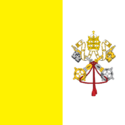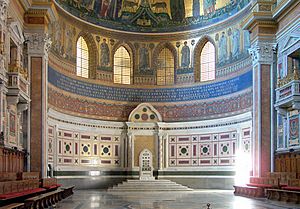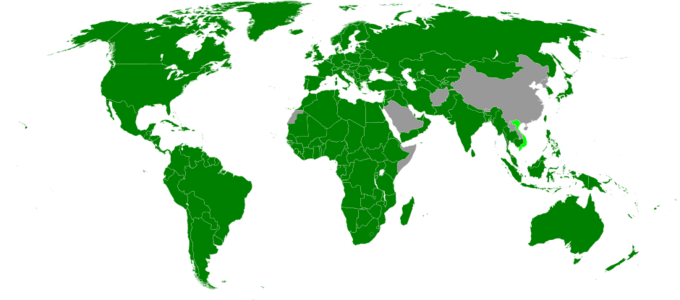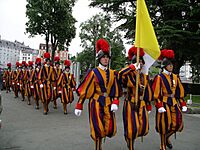Holy See facts for kids
Quick facts for kids
Holy See
|
|
|---|---|
|
|
|
| Ecclesiastical jurisdiction | Diocese of Rome Worldwide 41°54.2′N 12°27.2′E / 41.9033°N 12.4533°E |
| Official languages | Latin |
| Working language | Italian |
| Religion | Catholic Church |
| Demonym(s) | Papal Pontifical |
| Type | Apostolic Theocracy |
| Government | Unitary theocratic Catholic elective absolute monarchy |
|
• Pope
|
Francis |
|
• Cardinal Secretary of State
|
Pietro Parolin |
|
• Camerlengo of the Holy Roman Church
|
Kevin Farrell |
| Sovereign entity under international law | |
|
• Apostolic see
|
1st century by Saint Peter ("Prince of the Apostles") |
|
• Papal primacy
|
Early Church – Antiquity (Canon law; legal history) |
|
• Donation of Sutri
|
728 (territory in Duchy of Rome by Lombard King Liutprand) |
|
• Donation of Pepin
|
756 (sovereignty in Duchy of Rome reaffirmed by Frankish King Pepin) |
| 756–1870 1075: Dictatus papae 1177: Treaty of Venice (sovereignty reaffirmed by Emperor Frederick I of the Holy Roman Empire) |
|
|
• Prisoner in the Vatican
|
1870–1929 (under the Kingdom of Italy) |
| 1929– (Lateran Treaty with Italy) |
|
The Holy See (which means "Holy Chair" in Latin) is the central government of the Catholic Church. It also governs the Vatican City State. It includes the office of the Pope, who is the bishop of Rome. The Holy See guides the Catholic Church around the world. It also has the special status of a sovereign entity under international law.
Catholic tradition says that Saints Peter and Paul founded the Holy See in the first century. Because of the importance of Peter and the Pope, it is a main point of unity for Catholics everywhere. The Holy See is based in Vatican City, a tiny independent country inside Rome, Italy. The Pope is the leader of Vatican City.
The Holy See is managed by the Roman Curia. This is like the central government of the Catholic Church. The Roman Curia has different departments, similar to government ministries. The Cardinal Secretary of State is its main leader. Popes are chosen by a group of cardinals in a special election called a conclave.
People often call the Holy See "the Vatican." But Vatican City was created in 1929 by the Lateran Treaty. This treaty between the Holy See and Italy made sure the Pope could be independent. So, diplomats who represent the Pope around the world represent the Holy See, not Vatican City. The Holy See is the main government of the Catholic Church and Vatican City. The Catholic Church is also the world's largest non-government provider of education and healthcare.
The Holy See has diplomatic relationships with 183 countries. It signs agreements and works with many international groups. These include the United Nations and the Council of Europe.
Contents
What is the Holy See?
The word "see" comes from the Latin word sedes, meaning 'seat'. It refers to the special chair, or throne, of a bishop. The term "Apostolic See" can mean any place founded by one of the Twelve Apostles. But in the Catholic Church, it usually means the "See of Rome." This is because Catholics believe the Bishop of Rome (the Pope) is the successor of Saint Peter.
While St. Peter's Basilica in Vatican City is famous, the main church of the Holy See is actually the Archbasilica of Saint John Lateran. This church is located in the city of Rome, not inside Vatican City.
A Brief History
Catholic tradition says that Saint Peter and Saint Paul started the See of Rome in the first century. The Roman Emperor Constantine the Great recognized the Catholic Church in 313. Later, in 380, Emperor Theodosius I made it the official state church of the Roman Empire.
After the Western Roman Empire fell in 476, the Pope's legal authority grew. The Holy See gained land in 728 from the Lombard King Liutprand. This was called the Donation of Sutri. Then, in 756, the Frankish King Pepin the Short gave the Holy See more land and recognized its independence. This led to the creation of the Papal States.
The Papal States were a large territory with their own army from 756 to 1870. Popes had great power during this time. For example, Pope Leo III crowned Charlemagne as Roman Emperor in 800.
Even after Rome was attacked many times, the Holy See remained sovereign. However, its power was challenged at times. In 1870, the Kingdom of Italy took over the Papal States. This made the Pope a "Prisoner in the Vatican" until 1929.
On February 11, 1929, the Lateran Treaty was signed between the Holy See and Italy. This treaty created Vatican City as an independent city-state. It also gave the Holy See special rights over other properties in Rome and Italy. Since then, Vatican City has been distinct but under the full control of the Holy See.
How the Holy See is Organized
The Holy See is one of the few remaining absolute monarchies in the world. This means the Pope has full power. The Pope governs the Catholic Church through the Roman Curia. The Curia is a group of offices that manage church matters at the highest level.
It includes the Secretariat of State, which coordinates the Curia. The Cardinal Secretary of State is like the Pope's prime minister. Currently, this is Cardinal Pietro Parolin. The Secretary for Relations with States, Archbishop Paul Gallagher, acts as the Holy See's foreign minister.
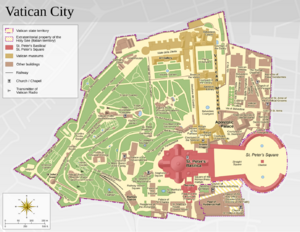
Only the Secretariat of State is located inside Vatican City. Other Curia offices are in buildings across Rome. These buildings have special rights, like embassies.
Important Curia departments include the Congregation for the Doctrine of the Faith. It makes sure Catholic teachings are correct. The Congregation for Bishops helps appoint bishops around the world. The Congregation for the Evangelization of Peoples oversees missionary work.
There are also three courts that handle legal matters. The Roman Rota hears appeals, especially about marriage annulments. The Apostolic Signatura is the highest court for appeals. The Apostolic Penitentiary deals with matters of conscience and grants special permissions.
The Prefecture for the Economic Affairs of the Holy See manages the Holy See's money. It oversees all offices that handle finances. The Prefecture of the Papal Household organizes papal events and ceremonies.
Pope Francis is working to reorganize the Curia. He wants it to focus more on helping the Church spread its message. He also wants more everyday people to be involved in its work.
The Holy See does not stop working when a Pope dies or resigns. During this time, called sede vacante, most Curia leaders step down. Only the Major Penitentiary and the Camerlengo of the Holy Roman Church continue their roles. The Camerlengo manages the Holy See's property and money. The College of Cardinals then governs the Church until a new Pope is elected.
In 2001, the Holy See had a revenue of about US$202 million. Its net income was about US$8 million. A 2012 report estimated the value of some Vatican property assets at over €680 million.
International Status
The Holy See is recognized as a subject of public international law. This means it has rights and duties like countries do. Even though the Holy See is not a country itself (Vatican City is), it acts like one in international affairs. It has a stable government and can make agreements with other states. It maintains diplomatic relations with 180 countries.
Diplomacy and Foreign Relations
The See of Rome has been recognized as a sovereign entity since the Middle Ages. The Holy See maintains formal diplomatic relations with many countries. It also has special relations with the European Union and the Sovereign Military Order of Malta. It also has a special relationship with the Palestine Liberation Organization.
The Holy See has 180 diplomatic missions around the world. Many of these missions cover more than one country or international group. The Secretariat of State handles all diplomatic activities.
The Holy See is a member of many international organizations. These include the International Atomic Energy Agency (IAEA) and the International Telecommunication Union. It is also a permanent observer in groups like the United Nations General Assembly and UNESCO.
Relationship with Vatican City
The Holy See is closely linked to Vatican City. But they are two separate and distinct entities. Vatican City is the independent territory that the Holy See governs.
After Italy took over the Papal States in 1870, the Holy See had no land of its own. But it still continued to send and receive diplomats. It kept relations with major powers like Russia and Austria-Hungary. Even without its own territory, the number of countries with diplomatic ties to the Holy See grew.
The Lateran Treaty in 1929 created Vatican City. This was done to make sure the Holy See was completely independent. It also guaranteed its sovereignty in international matters. Vatican City is a small country that supports the Pope's spiritual freedom.
It is the Holy See, not Vatican City, that has diplomatic relations with other countries. Foreign embassies are accredited to the Holy See. The Holy See also signs treaties with other sovereign entities. If needed, the Holy See will sign a treaty on behalf of Vatican City.
The Lateran Treaty also gives the Holy See special authority over several places in Rome. This includes the Papal Palace of Castel Gandolfo. This authority is similar to that of embassies in foreign countries.
Military
The Pontifical Swiss Guard was founded in 1506 by Pope Julius II. They are the Pope's personal bodyguards. They are listed under "Holy See" in the official yearbook, not under "State of Vatican City."
As of 2005, the Guard had 134 members. Recruits must be Catholic, unmarried Swiss men. They must be between 19 and 30 years old and at least 175 cm (5 feet 9 inches) tall. They also need to have completed basic training with the Swiss Armed Forces. Members are trained in bodyguard tactics and carry small arms and traditional halberds.
The police force in Vatican City is called the Corps of Gendarmerie of Vatican City. This force belongs to the city-state, not the Holy See.
The Holy See signed the UN treaty on the Prohibition of Nuclear Weapons. This agreement aims for the total elimination of nuclear weapons.
Symbols of the Holy See
The Holy See and Vatican City each have their own coat of arms. The main difference is how the keys are placed. The Holy See's coat of arms has the gold key on the left and the silver key on the right. The Vatican City State's coat of arms, created in 1929, has the keys reversed.
Related pages
See also
 In Spanish: Santa Sede para niños
In Spanish: Santa Sede para niños
- Global organisation of the Catholic Church
- Index of Vatican City-related articles
- Patriarchate
- Petitions to the Holy See
- Pontifical academy
- See of Constantinople


